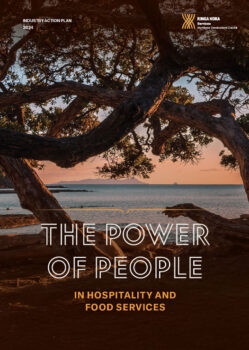
This year our visual theme for each of the Industry Action Plans has been developed with a Te Ao Māori context in mind.
For the Hospitality industry we lean into the symbolism of the Pohutakawa. It encapsulates the values of resilience, manaakitanga, connection to the land and people, and the enduring nature of welcoming and protecting others.

The Hospitality & Food Services industry acts as a gateway for many kaimahi entering the workforce or looking to change careers.
The industry enables them to pursue exciting and expansive careers. It also opens up new opportunities for people to progress in various areas, such as marketing, culinary roles, front of house, or management.
The nature of the industry is vast and diverse, offering a range of opportunities for kaimahi to advance and gain valuable life-long experience, which will serve them wherever they go.
Hospitality & Food Services provides opportunities for the people of Aotearoa to come together. It creates a backdrop for memories and experiences for visitors and locals to enjoy, and the industry dovetails neatly with our Tourism and Travel sectors. The industry comprises multiple roles and includes accommodation, catering, takeaway food, clubs (associations), and pubs, taverns and bars. The Hospitality & Food services industry is essential, contributing billions of dollars annually to New Zealand’s GDP.
Accommodation
Accommodation businesses include hotel chains, motels, campgrounds, and a range of residential accommodation such as serviced apartments and student residences. Some accommodation providers also have restaurants, and/or conference facilities.
Cafés and Restaurants
Cafés and restaurant services includes services where customers generally order and are served while seated (i.e. waiter/waitress service) and pay after eating.
Takeaway Food Services
Takeaway and convenience food services provide food ready to be taken away for immediate consumption.
Pubs, Taverns & Bars
Businesses serving alcoholic beverages for consumption on the premises such as bars, hotel bars, nightclubs, pubs, taverns and wine bars. These businesses may also provide food services, gambling services and/or present live entertainment.
Catering Services
Catering provides services at specified locations, or events such as private events, conference events, or airline catering.
Clubs
Associations mainly engaged in providing hospitality services to members. These hospitality services include gambling, sporting, or other social or entertainment facilities.

New Zealand’s Hospitality & Food Services workforce truly provides the ‘face’ of our nation. Hospitality workers are found everywhere, from restaurants, bars, clubs, and cafés in our urban centres to the most remote regions. Day and night, the Hospitality workforce sets the scene for all customers, both international and domestic, to socialise and experience the best that New Zealand has to offer.
The large workforce of 175,000 brings a wealth of expertise, experience and skills, contributing to a lasting impression of professionalism and service standards that form the backbone of our reputation as an international destination1. The industry experienced a sharp rebound since the pandemic, with the workforce expected to grow to 182,000 workers in 2025 and 191,000 by 2028. However, recent economic uncertainties and the rising cost-of-living pressure, is creating significant challenges for the industry.
Training is a focus for the industry, with the Hospitality New Zealand Strategy 2024-2029 stating the importance of providing world-class training and resources for business owners and of supporting kaimahi with their professional development. Despite the recognition of needing suitable skills for the industry to thrive, there continues to be a declining uptake of training. While several organisations provide multiple work-based training options and internships, there are nine formal qualifications for the Hospitality and Food industry, including:
There has been a recent review of the suite of cookery qualifications as part of the Culinary Koha project, which has confirmed that these qualifications develop the skills needed in chef roles and in managing professional kitchens. Employers recognise the value of these qualifications as demonstrated by having staff participate in on-job learning and by employing qualified chefs.

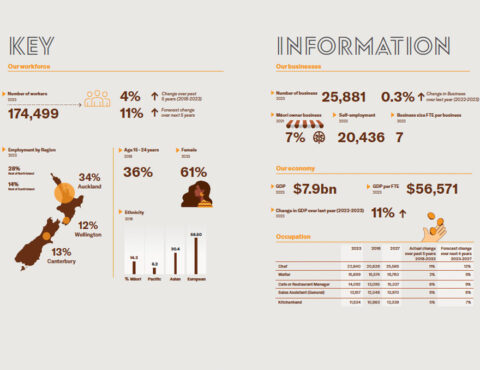
Explore Hospitality & Food industry workforce demographic, business, and economy statistics, and education and training data.

The hospitality industry is facing significant challenges due to the combined impacts of post-pandemic recovery and the ongoing cost-of-living pressure. These pressures are creating substantial hardships for both businesses and their workers. The current economic environment is intensifying these issues, leading to reduced profitability, operational constraints, and increased stress levels among hospitality staff.
While some operators report buoyancy in their trade, others are experiencing declines
in both foot traffic and spending.
The return of international tourists during the summer months has provided a much-needed boost, serving as a silver lining amidst ongoing challenges.
The Hospitality and Food industry is highly sensitive to shifts in discretionary spending, grappling with a persistent skills shortage, and operates on notoriously narrow margins.

Recent surveys from the Restaurant Association (one of the key industry peak bodies) reported that up to 62% of business respondents had to temporarily close due to ongoing staffing shortages. In addition, 80% of members are running establishments that are not fully staffed, 56% of respondents indicated that recruiting for junior roles was challenging, and 84% of employers say it is difficult or extremely difficult to recruit for senior roles.
This shortage is particularly felt in key roles with medium, and high skills needs including chefs, with many businesses required to reduce opening hours due to shortages.

The rapid evolution of technology presents an opportunity for hospitality businesses to enhance their operations by implementing technological features.
Businesses are leveraging technology to streamline back-office tasks and reduce time spent on routine, menial activities.
Incorporating technological business solutions allows for a greater focus on human interactions, improving customer service and overall experience.
Some businesses are increasingly incorporating technology into the customer experience such as kiosk ordering and AI-supported ordering systems.

Customers are increasingly seeking authentic experiences and are also interested in experiences that align with values such as sustainability and social and environmental responsibility. Customers are becoming more interested in the stories and values behind the businesses they support, including alignment with their own values.
Customers are becoming more interested in the stories and values behind the businesses they support including alignment with customer values.
By focusing on personalised experiences and potentially smaller group offerings, there is opportunity to shift international and domestic customers from seasonal to year-round productivity.
Due to these shifts in consumer habits, businesses benefit from understanding their customers, including tailoring offers to meet customer needs and preferences, which can enhance customer satisfaction and loyalty.

Well-being challenges are prevalent for the hospitality workforce due to the demanding nature of the industry, however the combined impact of post pandemic recovery and current economic climate is exacerbating these challenges.
There is momentum in the industry to support the well-being of workers, initiating proactive approaches.
Hospitality New Zealand, the Restaurant Association, and Helmet have formed a partnership to strengthen the hospitality sector’s ability to support mental health. The initiative uses technology to help peers and individuals support those struggling with mental health issues. The partnership emphasises the industry’s commitment to addressing mental health challenges through innovative tools that empower individuals to assist their peers.


Within accommodation, holiday parks have high seasonal fluctuations with 45% of annual guest nights in December to February. Therefore, they are reliant on part-time, seasonal or casual labour.
Technological advances are supporting the accommodation industry to streamline operations such as management and booking systems using online booking, mobile payments and contactless check in.

There is a projected increase in demand for chefs between 2022 and 2028 (from 22,153 to 25,681). Despite this there is a shortage of chefs, especially at the senior level.
A decline in discretionary income means business has slowed, and many businesses have struggled to remain open. For the first time we are observing more cafes closing than opening in Aotearoa.
A higher health consciousness among consumers means restaurants and Cafés need to expand their menus to cater to more individuals.

Takeaway and convenience food
There is high competition between fast food and takeaway operators.
Traditional fast food chains are expanding their menus to include healthier choices to cater to changing consumer demands, including more salads and plant-based options.
Technology such as contact-free delivery, automation and self-service kiosks is enabling businesses to streamline processes, reduce wait times and enhance the customer experience.

Pubs, taverns and bars
Per capita alcohol consumption has fallen in line with rising health consciousness. Consumers, especially those aged 18 to 24, have increasingly followed health and fitness trends, which encompass reducing their alcohol intake.
High competition keeps profit margins slim. Pubs, bars, and nightclubs tend to imitate each other’s prices, averse to severely marking up food and drink options at the risk of losing sales.

Catering
Caterers face pressure from volatile raw material costs, economic uncertainty, and inflation, forcing them to adjust pricing strategies. To cut costs, some businesses are trying to reduce overheads by decreasing full-time employee numbers.
More players in the market mean caterers need to fight harder for business by keeping prices competitive. This means profit margins are shrinking for many.
Businesses also need to change traditional business practices to keep up with customer demands and trends to maintain their reputations.

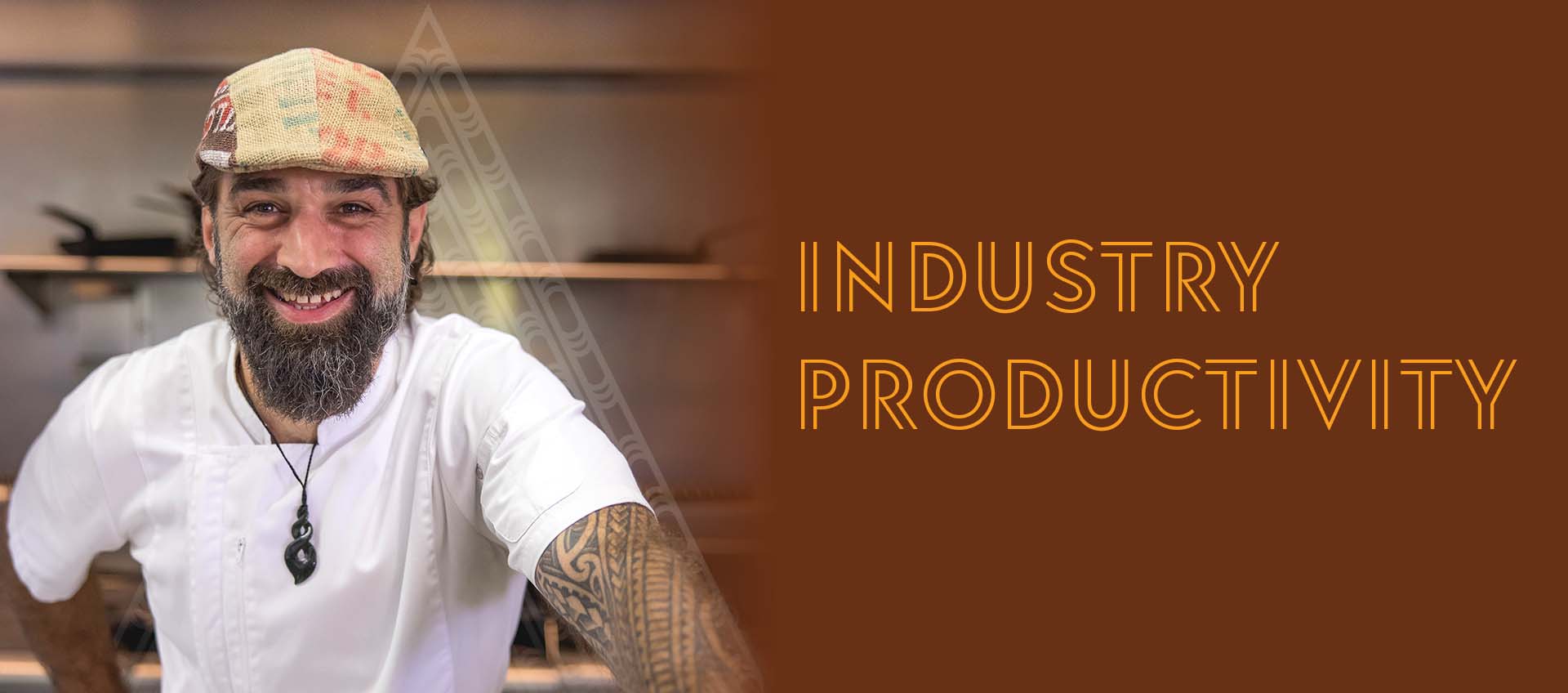
Productivity is built on decades of investment—in skills, knowledge, technology, and relationships. Productivity in business can impact a range of different areas, including employers, firm dynamics, technology diffusion, and innovation. Achieving higher productivity improves our overall well-being, by increasing the nation’s and our ability to produce and afford the goods and services that underpin a happy, healthy life.
With the increasing tougher operating conditions and raising costs, getting greater value from the Hospitality workforce is more important than ever. The ongoing sustainability of the industry will depend on its ability to lift productivity.
Technology is helping business efficiency and productivity. Technological advances are helping the accommodation industry streamline operations, reduce wait times, boost customer satisfaction, and enhance the customer experience, such as:
Innovation and active change contribute to building resilience to future disruptions, whether economic, environmental, or social. This involves adopting flexible business models, diversifying revenue streams, and being prepared to pivot quickly in response to changing circumstances.
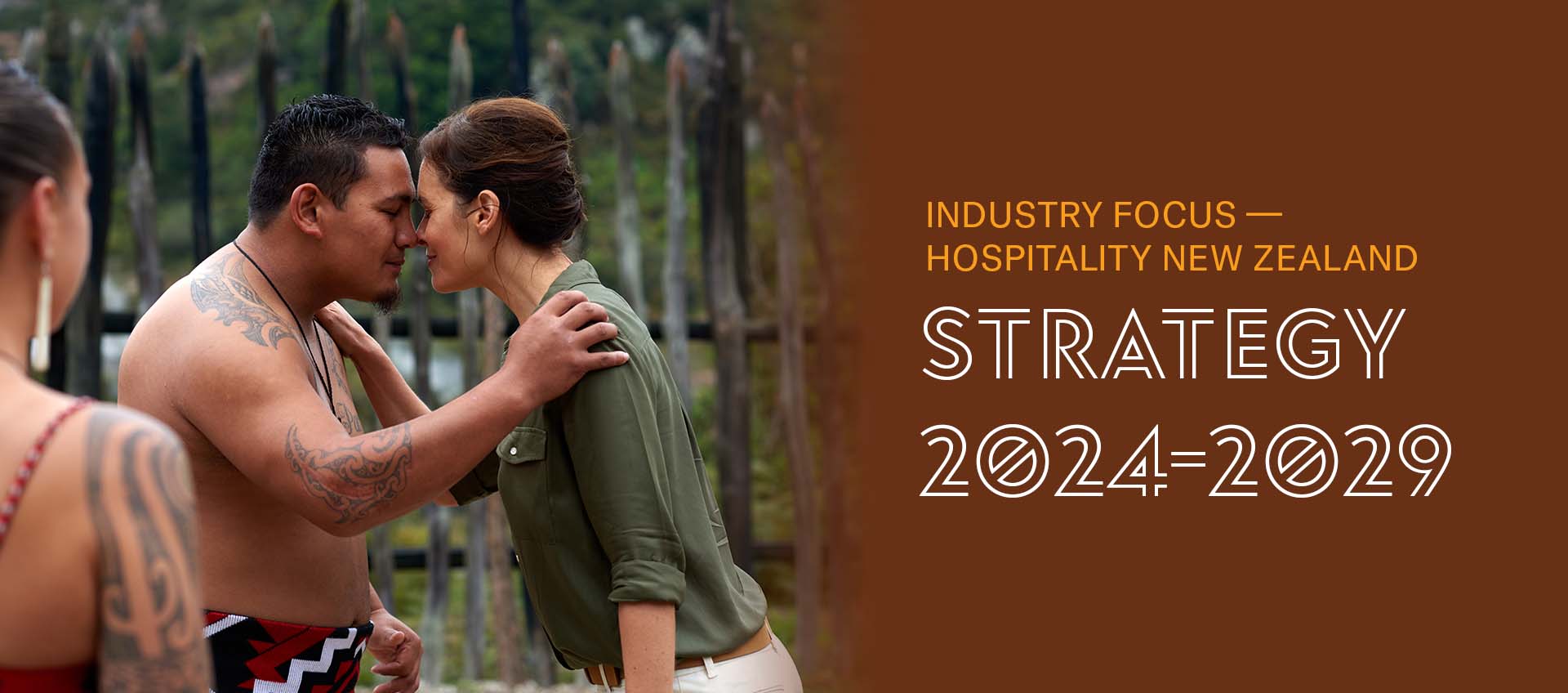
As an industry that significantly contributes to the national economy and community, it is crucial to ensure its resilience and sustainability. Hospitality New Zealand’s (HNZ) Strategy for 2024-2029 is a five-year document outlining a comprehensive approach to stimulating and strengthening the industry.
The strategy places a strong emphasis on adapting to the evolving expectations of customers. Today’s consumers are increasingly seeking experiences that are not only authentic and personalised but also aligned with their values. Sustainability, social responsibility, and a deeper connection to the stories behind the services they consume are becoming more important to customers. This strategy acknowledges these shifts and encourages the industry to embrace them. By aligning with these new customer expectations, businesses within the hospitality sector can differentiate themselves, build stronger relationships with their clientele, and deliver experiences that resonate on a deeper level. This customer-centric approach is vital for maintaining relevance and competitiveness in an ever-changing market.
The strategy envisions a future where technology supports rather than replaces human connection, enabling businesses to strike the right balance between efficiency and personalised service. As the market becomes increasingly competitive, the ability to tailor offerings to meet specific customer needs will become even more crucial. This strategy advocates for a more deliberate and data-driven approach to customer engagement. By gaining deeper insights into what customers truly value, businesses can design and deliver experiences that not only meet expectations but exceed them. This approach will help to drive repeat business and ensure that the industry remains in sync with the changing demands of its customer base.
The demanding nature of the industry has long placed stress on workers, but recent global events have intensified these challenges. The strategy recognises that the well-being of the workforce is not only imperative to staff but also for businesses as well. A healthy, supported, and motivated staff is essential for maintaining high levels of productivity, reducing turnover, and ensuring that businesses can continue to deliver exceptional service. By prioritising mental health and wellbeing, the industry can build a more resilient workforce that is better equipped to navigate the uncertainties and pressures of the economy.
To grow and maintain a sustainable future, the strategy encourages industry to invest in approaches that build resilient and responsible businesses. Incorporating initiatives and supporting projects that improve environmental performance and promote sustainable practices is a key focus to ensure that the sector not only thrives economically but also contributes positively to the environment and society.
The strategy supports strengthening ties with local communities and fostering a sense of community involvement to enhance the profile and relevance of hospitality businesses. This can include supporting local suppliers, engaging in community events, and contributing to local causes. Strengthening bonds within the community and between the sector and its stakeholders is another way to ensure both domestic and international customers have exceptional experiences while supporting businesses and communities.
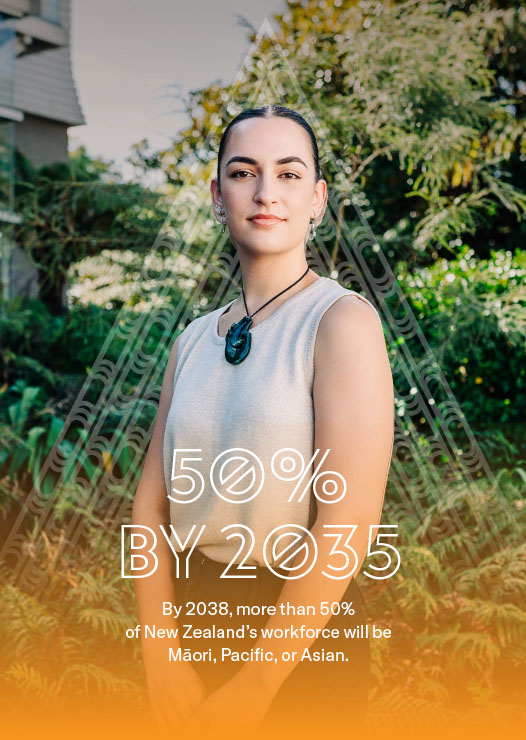
This has implications for the Service Sector and more specifically for the Hospitality industry. It will change who services are delivered for and by. It will become more important for the industry to reflect its workforce and customers, to consider the range of offerings to meet customer demand, and for the workforce to be culturally aware.
Each of these groups makes a unique contribution to the Service sector, and businesses will benefit from recognising this contribution and being responsive to their individual needs.

Approximately 14% of the industry is Māori, who are mainly in roles within catering, clubs, pubs, and taverns. There are fewer Māori in roles within cafes and accommodation, including owner-operators, self-employed and employees.
Māori business support
Support initiatives for small, and medium-sized Māori businesses were a priority for Māori industry to transition to the new normal and adapt to the continuing fluctuations of the economic climate.
Supporting Māori businesses to operate in a way that is viable and representative of Māori culture aligns with both value and values.
Te Ao Māori practices and values are integrated into the delivery of the guest experience. By showcasing these unique attributes, businesses can attract both domestic and international visitors seeking authentic experiences.
Skills and training recognition and support
Te Ao Māori recognition and implementation ensure delivering experiences that are authentic.
Initiatives such as Te Ao Māori training for staff and normalising the use of te reo Māori in service delivery are fundamental for enhancing Te Ao Māori within operations and enhancing the upskill of Māori and non-Māori staff.
Relationships and communities
Māori industry contributes to and is supported by communities and the environment. Prioritising these relationships ensures long term planning for Māori in the industry.
Seasonal fluctuations can mean seasonal employment for both Māori employers and employees of Māori and Māori employees. Networking relationships to address challenges around seasonal fluctuations, particularly for accommodation, food and beverage services, can contribute to stability employment for current and potential staff.

Approximately 6% of the Hospitality industry comprises Pacific workers. The Pacific Hospitality industry recently held its first meeting to discuss and strategise growth for Pacific people in hospitality, both as a workforce and as business owners.The following initiatives were identified and discussed.
Collaboration
Economic collaboration within the Pacific hospitality industry focuses on strengthening economic connections and partnerships across different Pacific nations. This means working together to improve trade, investment, and opportunities across the Pacific. Improving Economic Performance. By improving the movement of people, goods, and services throughout the Pacific, we can lift the economic performance of the Pacific Hospitality industry. This means more jobs, better businesses, and stronger economies. Simplifying immigration and visa processes can make it easier for workers to move between countries for work placements.
Sharing knowledge and resources: Collaborating economically allows Pacific nations to share resources, knowledge, and skills. This can lead to better management of resources and more innovative solutions to common problems. Developing technology solutions can improve cross-country relationships and ongoing communication.
Pacific small businesses
Many hospitality businesses in the Pacific are SMEs. Economic collaboration can provide these businesses with the training and support they need to grow and succeed on a larger scale. Conduct needs assessments to identify what’s working well, gaps, and region-specific needs.
Strengthening Relationships
Networking relationships focus on building and maintaining connections among hospitality professionals, associations, and organisations across the Pacific region. This includes creating opportunities for these groups to collaborate and support each other empowering Pacific groups to share successful strategies and practices, and supporting increased innovation.
Industry wide relationships across the Pacific can open career opportunities for hospitality workers by connecting them with a wider pool of potential employers and training programmes. Developing a database of best practices and information will inform decisions and strategies as well as provide a platform for staff-sharing opportunities during off-seasons.
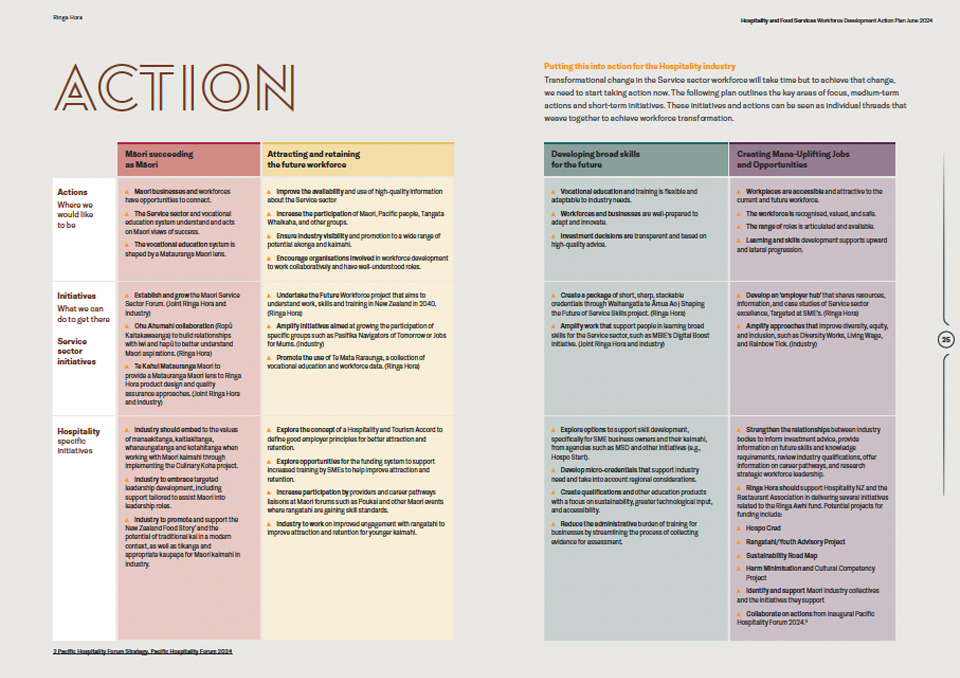
Transformational change in the Service sector workforce will take time but to achieve that change, we need to start taking action now. The following plan outlines the key areas of focus, medium-term actions and short-term initiatives. These initiatives and actions can be seen as individual threads that weave together to achieve workforce transformation.
Download our actions and progress: